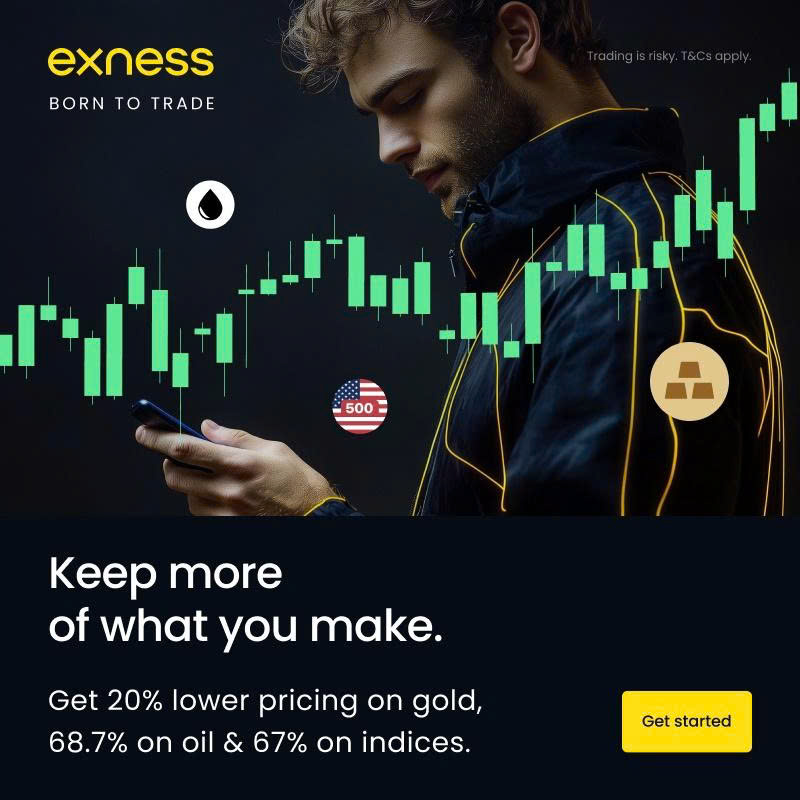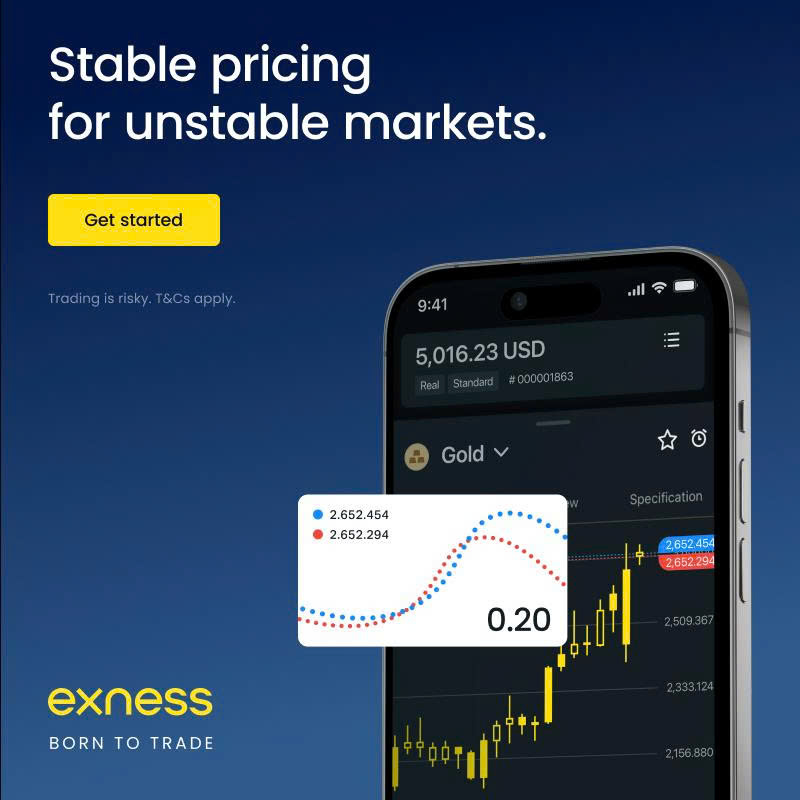
10 minute read
How Does Exness Make Money? A Comprehensive Guide
from Exness
by Exness Blog
Exness, a globally recognized online brokerage firm founded in 2008, has solidified its position as a leading player in the forex and CFD trading industry. With over 700,000 active clients across 150 countries and a reputation for transparency, competitive spreads, and innovative trading tools, Exness has become a go-to platform for both novice and professional traders. But how does Exness make money while offering low spreads and commission-free accounts? In this comprehensive guide, we’ll explore the various revenue streams that fuel Exness’s success, shedding light on its business model and what it means for traders.

💥 Trade with Exness now: Open An Account or Visit Brokers 🏆
Understanding Exness: A Brief Overview
Before diving into how Exness generates revenue, let’s set the stage with a quick look at what makes this broker stand out. Exness operates as a multi-asset broker, offering trading in forex, commodities, indices, stocks, and cryptocurrencies. Its user-friendly platforms, including MetaTrader 4 (MT4), MetaTrader 5 (MT5), and the proprietary Exness Trader app, cater to traders of all experience levels. Regulated by top-tier authorities like the Financial Conduct Authority (FCA) in the UK and the Cyprus Securities and Exchange Commission (CySEC), Exness prioritizes security and transparency, which has earned it a loyal client base.
Exness’s business model revolves around facilitating trades between buyers and sellers while providing a seamless trading environment. But like any business, it needs to generate revenue to sustain its operations, innovate, and grow. So, how does Exness make money? Let’s break it down into its primary revenue streams.
1. Spreads: The Core of Exness’s Revenue
One of the primary ways Exness generates income is through spreads, the difference between the bid (selling) and ask (buying) prices of a financial instrument. When you place a trade on Exness, you’ll notice that the price you buy at is slightly higher than the price you sell at. This difference, known as the spread, is where Exness earns a portion of its revenue.
How Spreads Work
Spreads are measured in pips, the smallest price movement in forex trading. For example, if the bid price for EUR/USD is 1.2000 and the ask price is 1.2002, the spread is 0.2 pips. Exness charges this spread on every trade, effectively capturing a small profit from each transaction. The size of the spread depends on market conditions, such as volatility and liquidity, as well as the type of account you use.
Why Exness’s Spreads Are Competitive
Exness is known for offering some of the tightest spreads in the industry, starting from 0.0 pips on certain account types like the Raw Spread and Zero accounts. This competitiveness attracts high-volume traders, which increases Exness’s overall trading volume and, consequently, its spread-based revenue. Even with low spreads, the sheer volume of trades processed daily—often billions of dollars—ensures a steady income stream.
Fixed vs Floating Spreads
Exness offers both fixed and floating spreads, depending on the account type. Floating spreads vary with market conditions, while fixed spreads remain constant. By offering flexibility, Exness appeals to a wide range of traders, further boosting its trading volume and spread income.
2. Commissions: A Direct Revenue Source
In addition to spreads, Exness earns money through commissions on certain account types, particularly those designed for professional traders, such as the Raw Spread and Zero accounts. Unlike spread-based accounts, these accounts charge a fixed commission per trade, typically calculated per lot traded. For example, the Raw Spread account charges a commission of up to $3.50 per lot per side.
Why Commissions Matter
Commissions provide Exness with a predictable revenue stream, especially from high-frequency traders who execute large volumes of trades. These traders often prefer accounts with ultra-low spreads and are willing to pay commissions for better pricing and faster execution. By offering both commission-based and commission-free accounts, Exness caters to diverse trading styles, maximizing its revenue potential.
ECN Model and Commissions
Exness also operates an Electronic Communication Network (ECN) model for some accounts, where trades are matched directly with liquidity providers. In this model, Exness acts as an intermediary and earns commissions on each trade rather than relying solely on spreads. The ECN model is popular among professional traders who value transparency and direct market access, further contributing to Exness’s commission-based revenue.
3. Market Maker Model: Managing Trades Internally
Exness employs a market maker model for some of its accounts, where it acts as the counterparty to its clients’ trades. Instead of routing trades directly to the open market, Exness executes them internally, managing the risk through sophisticated systems. This model allows Exness to control spreads and ensure fast execution, which is a key selling point for traders.
How Market Makers Earn Money
As a market maker, Exness profits from the spread and, in some cases, from the price movements of trades. When a trader opens a position, Exness takes the opposite side, hedging its exposure in the broader market if necessary. By managing a large pool of trades, Exness can balance its risk and generate consistent profits, even in volatile markets.
Transparency in the Market Maker Model
While some traders are wary of market makers due to potential conflicts of interest, Exness mitigates these concerns through strict regulatory oversight and transparent pricing. The broker’s commitment to fair trading practices, such as low spreads and fast execution, has helped it build trust among clients, making the market maker model a viable revenue source.

💥 Trade with Exness now: Open An Account or Visit Brokers 🏆
4. Social Trading: Earning Through Strategy Providers
Exness has tapped into the growing popularity of social trading with its Exness Social Trading platform, launched in 2019. This platform allows experienced traders (strategy providers) to share their trading strategies with others (investors), who can copy their trades in real time. Strategy providers earn commissions of up to 50% based on the profits generated by their followers, while Exness benefits from increased trading volume.
How Exness Profits from Social Trading
Every trade executed through the Social Trading platform incurs spreads or commissions, depending on the account type. As more investors copy strategies, the total trading volume on the platform rises, boosting Exness’s revenue. Additionally, the platform’s popularity—evidenced by over 100,000 downloads on iOS and Android—drives new client acquisition, further increasing trading activity.
Benefits for Traders
Social trading is a win-win for both Exness and its clients. Investors gain access to proven strategies without needing extensive market knowledge, while strategy providers earn passive income. For Exness, this innovative feature enhances its brand appeal and generates additional revenue through spreads and commissions.
5. Affiliate Programs: Incentivizing Referrals
Exness’s affiliate program is another significant revenue driver, allowing individuals and businesses to earn commissions by referring new clients to the platform. Affiliates receive up to $1,850 per referred client who signs up and starts trading, which is notably higher than the industry average.
How the Affiliate Program Works
Affiliates promote Exness using unique referral links on their websites, blogs, social media, or email campaigns. When someone clicks the link, registers, and trades, the affiliate earns a commission. Exness benefits by acquiring new clients at a relatively low cost, while affiliates monetize their audiences.
Why It’s Effective
The affiliate program leverages the power of word-of-mouth marketing, reaching potential traders through trusted sources like forex blogs and influencers. By offering generous commissions, Exness incentivizes affiliates to promote its services, driving client growth and, consequently, trading volume. This increased activity translates into more spread and commission revenue for Exness.
6. Overnight Financing (Swap Fees)
Another way Exness makes money is through swap fees, also known as overnight financing or rollover fees. These fees are charged when a trader holds a position open overnight, typically after 10 PM GMT. Swap fees are based on the interest rate differential between the two currencies in a forex pair or the financing costs for other instruments like commodities or cryptocurrencies.
How Swap Fees Work
For example, if you hold a long position on EUR/USD overnight, you may pay or receive a swap fee, depending on the interest rates of the euro and the U.S. dollar. Exness calculates these fees transparently and displays them in the trading platform, ensuring traders can factor them into their strategies.
Swap-Free Accounts
Exness also offers swap-free accounts for clients in certain regions or those who prefer not to pay overnight fees, such as Islamic traders. While these accounts don’t generate swap revenue, Exness compensates by earning through spreads or commissions, maintaining profitability across its diverse account offerings.
💥 Trade with Exness now: Open An Account or Visit Brokers 🏆
7. Additional Revenue Streams
Beyond its core revenue sources, Exness generates income through supplementary services and features:
a. Premium Services
Exness offers premium tools like VPS hosting for traders who require uninterrupted access to the markets. While some services are free, others may involve fees, contributing to revenue.
b. Educational Content and Analytics
Exness provides free educational resources, such as webinars, tutorials, and market analysis, to attract and retain clients. While these are not direct revenue sources, they drive client engagement, leading to higher trading activity and, ultimately, more income from spreads and commissions.
c. Withdrawal and Deposit Fees
While Exness offers instant deposits and withdrawals with no fees for most payment methods, certain transactions may incur small charges, depending on the payment provider. These fees, though minimal, add to the broker’s revenue.
Why Understanding Exness’s Revenue Model Matters
For traders, understanding how Exness makes money is more than just curiosity—it’s a strategic advantage. Here’s why:
· Informed Decision-Making: Knowing Exness’s revenue streams helps you anticipate costs like spreads, commissions, or swap fees, allowing you to optimize your trading strategy.
· Evaluating Conflicts of Interest: By understanding the market maker model, you can assess whether Exness’s practices align with your trading goals. Its regulatory compliance and transparency mitigate most concerns.
· Choosing the Right Account: Exness’s diverse account types (Standard, Raw Spread, Zero, Pro) cater to different trading styles. Understanding how Exness earns from each can guide you to the most cost-effective option.
How Exness Stays Competitive
Exness’s ability to generate revenue while maintaining a client-centric approach sets it apart from competitors. Here are a few strategies that contribute to its success:
· Low Spreads and Fees: By offering some of the lowest spreads and commission-free accounts, Exness attracts high-volume traders, boosting its revenue through scale.
· Regulatory Compliance: Licenses from the FCA, CySEC, and other regulators enhance trust, encouraging more clients to trade with Exness.
· Innovative Features: Tools like instant withdrawals, stop-out protection, and real-time market alerts differentiate Exness, driving client retention and trading activity.
· Global Reach: With support in 15 languages and a presence in over 150 countries, Exness taps into diverse markets, expanding its client base and revenue potential.
Conclusion: A Balanced Approach to Profitability
Exness makes money through a combination of spreads, commissions, the market maker model, social trading, affiliate programs, swap fees, and supplementary services. Its ability to balance profitability with competitive pricing and transparency has made it a trusted name in the trading industry. For traders, understanding Exness’s revenue model provides valuable insights into costs and helps optimize trading decisions.
Whether you’re a beginner exploring forex or a seasoned trader diversifying your portfolio, Exness offers a robust platform backed by a sustainable business model. By leveraging its revenue streams effectively, Exness continues to innovate and deliver value to its global client base.
💥 Note: To enjoy the benefits of the partner code, such as trading fee rebates, you need to register with Exness through this link: Open An Account or Visit Brokers 🏆
Read more:

